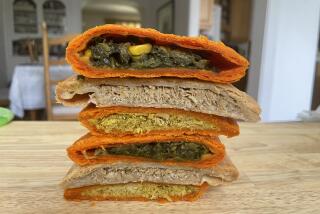Firing up the grill? Make it a ‘rare’ occasion
BARBECUE definitely gives apple pie a run for its money in the competition for all-American food. More than 17 million barbecues were sold in 2006, according to the Hearth, Patio & Barbecue Assn. And 81% of Americans own a barbecue, more than half grill year-round, and 47% barbecue at least twice weekly in the summer months.
The truth is, pretty much anything tastes better hot off the grill. It’s something about the flames, the smoke, the tongs, the-meat-on-metal sizzle that no broil or fry pan can reproduce. Even a tofu dog almost comes alive with a set of grill marks.
For the record:
12:00 a.m. June 11, 2007 For The Record
Los Angeles Times Monday June 11, 2007 Home Edition Health Part F Page 5 Features Desk 1 inches; 68 words Type of Material: Correction
Grilling: A May 28 Health article on the health effects of eating barbecued meat incorrectly referred to a scientist as Zei Wheng. His name is Wei Zheng. The article also said that many processed meats contain nitrates and that these have been shown to increase cancer risk. The chemicals most commonly used in curing meat today, and which also have been shown to increase cancer risk, are nitrites.
Nothing that good can be good for us, of course. And yes, the natural chemicals that give barbecued foods their trademark crusty-brown smokiness are toxic and carcinogenic. Researchers have linked consumption of flame-grilled meat to all sorts of ailments: breast, prostate and colon cancer; diabetes; glaucoma; heart disease; and Alzheimer’s disease.
Fumes from burning fat drippings, along with smoke from wood and charcoal, add another layer of carcinogenicity (as well as deliciousness) to grilled foods.
And let’s not forget the foods themselves. A diet high in red meat -- a favorite of U.S. backyard cooks -- is a known cancer risk factor.
But you don’t have to convert to a raw food diet yet. Barbecue chemicals may be potent toxins in petri dishes and mice, but the evidence that they do the same in humans, at the doses we’re exposed to, is weaker.
Most studies find a significant increase in cancer risk only for people who eat several portions of well- or very well-done meat a week. And even then, the risk is often small. For example, a 2005 study in Cancer Research found a 21% increase in the risk of developing colon cancer precursors for people eating as much as 18 ounces of well-done red meat per day. The bottom line: A twice-weekly date with a medium-rare steak is unlikely to give you cancer any time soon.
What’s more, in addition to reducing portion size and frequency of grilling or developing a taste for steak tartare, there are many simple changes you can make to your grilling techniques to drastically reduce the toxicity of your barbecue with little adulteration of taste (see sidebar). Which is good, because you won’t find many takers in the “give up steak for summer” campaign.
The best-known toxic barbecue chemicals are heterocyclic amines, or HCAs, which form under high heat conditions -- such as grilling -- from amino acids, sugars and a muscle meat chemical called creatine. Almost any meat cooked above 300 degrees Fahrenheit, when it begins to brown, will have HCAs, but as a general rule, the levels increase sharply with higher cooking temperatures and longer cooking times.
For example a steak cooked until just rare -- about 15 minutes or so -- has just 2.5 nanograms of one common HCA per gram of food. Wait until that steak is black and crispy -- about 40 minutes -- and that value rises more than tenfold to 30 nanograms per gram.
Chicken breasts are even worse. A nicely blackened grilled breast, cooked for about 40 minutes, has 480 nanograms of the same cancerous HCA per gram of meat. Compared with other high-heat cooking methods such as pan-frying or oven broiling, grilling almost always leads to the biggest, baddest HCA numbers.
In laboratory tests, high doses of HCAs have proved to be potent carcinogens and tumor promoters. So, too, have tests on another class of cooking-related meaty carcinogens, PAHs, or polycyclic aromatic hydrocarbons. Whereas HCAs are generated by any high-heat cooking method, PAHs are specifically formed from the close relationship of food, fire and smoke in grilling and Southern barbecue.
PAHs are technically the incomplete combustion products of fuel and are best known as components in air pollution and cigarette smoke. However, the World Health Organization estimates that 80% to 90% of our exposure to PAHs comes through food. Smoke clouds from charcoal grills and those fat drip flare-ups are packed with PAHs. And, again, the longer the cooking or smoking time, the greater the coating of carcinogens.
The extra whammy of PAHs, in addition to HCAs, is probably why a high intake of grilled, well-done meats is worse than that of broiled or fried meat. One 1999 study led by cancer and cooking expert Rashmi Sinha, a senior investigator at the National Cancer Institute, found that for every 2.5 ounces of grilled meat consumed per week, colon cancer risk rises 26%. For frying, it was only 10%.
Still, the overall evidence of the malignant effects of PAHs and HCAs on people has been less than overwhelming.
Some studies do find that a general preference for, or high daily consumption of, well-done or very well-done red meat (black on the outside, gray in the middle) is a risk factor in prostate, stomach, breast and colorectal cancer. For example, a 2002 study of 1,658 men and women from North Carolina found that those who ate 2 ounces of well- or very well-done meat a day had a 70% increase in colon cancer risk. Similarly, a 1998 study of nearly 42,000 women from Iowa found that those who preferred to eat their steak, hamburgers and bacon very well-done were 4.62 times more likely to get breast cancer than women who liked their red meats rare or medium done.
But other studies find no connection between cooking methods, meat doneness and cancer risk. A 1999 study of nearly 33,000 women in the Nurses’ Health Study in Massachusetts found no increase in breast cancer risk related to meat cooking habits. A study of 800 New Zealand men found barely any connection between meat doneness preferences and prostate cancer.
“The existing literature is quite inconsistent, but I think it is reasonable to say that if there were large risks due to the cooking methods, we would have seen them by now,” says Dr. Walter Willett, Fredrick John Stare professor of epidemiology and nutrition at the Harvard School of Public Health.
Roger Clemens, a spokesman for the Institute of Food Technologists and professor of molecular pharmacology and toxicology at USC, says he is similarly unconvinced. “All foods contain a variety of naturally occurring toxins. The dose in which we consume them is so small that they don’t really have an impact on our health,” he says.
But Dr. Zei Wheng, director of the Vanderbilt University epidemiology center, who has been studying the link between meat doneness and breast cancer for the last decade, doesn’t agree. He believes that the risks are hard to detect in human studies because of nuances of genetics.
For example, Wheng’s analysis of the 42,000 women from the Iowa Women’s Health Study found that women who carry one version of a gene for a particular metabolizing enzyme showed no increase in breast cancer risk no matter how charred they liked their red meat. (The gene causes the enzyme, which is involved in activation of HCAs, to convert the compounds more slowly.)
But women with a hankering for blackened burgers and who had a different, “fast” copy of the enzyme had eight times the breast cancer risk of those who liked their meat rare.
Mariana Stern, assistant professor of preventive medicine at USC, also believes genetic variations are clouding results. She is sifting through 20 metabolism genes and 30 DNA repair genes to understand the link between meat consumption and colorectal cancer risk. “There may be people that can eat grilled meat everyday and nothing will happen to them,” she says. But with so many genes involved, she says, everyone needs to watch their grilled meat intake.
If the evidence seems smoky for PAHs and HCAs, it’s even more confusing for a class of toxic cooking chemicals that are making waves in the nutrition world. Called advanced glycation end products, or AGEs, they are flavorful chemicals generated when all foods are cooked, processed and browned under high heat.
Foods high in fat and with a high degree of processing seem to be the worst AGE risks: Hot dogs, butter and Parmesan cheese are as bad as it gets.
AGEs are powerful oxidants. Animal and human studies have shown that they can damage cells and trigger widespread inflammation throughout the body. They are implicated in many chronic diseases of aging: Accumulation of AGEs in the brain is linked to Alzheimer’s disease, accumulation in the eyes to glaucoma, buildup in arteries to premature stiffening, buildup in the blood to insulin resistance and diabetes.
Scientists are even more divided as to how concerned we should be about these compounds in our diets than they are about HCAs or PAHs.
For one thing, AGEs, unlike HCAs or PAHs, form spontaneously in our bodies, says professor Paul Thornalley at the University of Warwick in England. For another, if we eat them, they have a tough time surviving digestion, only weakly move into the bloodstream and are mostly filtered out by the kidneys in healthy people. So, he says, although AGEs are harmful, it’s unclear whether eating them causes damage.
But Dr. Helen Vlassara at Mount Sinai Medical School in New York is so convinced of their potential harm she wants the AGE content of food marked on food labels, right beside calories and trans fats.
Just last month, Vlassara published two studies: One found that the amount of AGEs we consume leads to higher levels of the chemicals in the bloodstream of both old and young participants and increases signs of cellular stress and inflammation. The second found that cutting the lifetime levels of dietary AGEs by half led to a longer lifespan in mice.
Vlassara believes that everyone should cut their consumption by reducing intake of processed foods and using low-temperature, moist cooking methods such as stewing.
“Everybody likes the taste of grilled and baked foods,” she says. “The idea here is not to deny the facts and continue eating ourselves to death but to think a little bit more critically about what we put in our mouths.”
Jeffrey Steingarten, food writer for Vogue magazine, thinks very critically about what he puts in his mouth and has yet to find sufficient evidence to steer clear of a perfectly done steak -- which, in his estimation, is somewhere between rare and medium rare.
For those who choose to grill their steaks to the blackened point of well-done shoe leather, his tongue-in-cheek opinion is simple: “If you eat a steak like that, you don’t deserve to live.”
But Steingarten settles on a point that most researchers of food-based diseases would agree on, despite the plethora of conflicting evidence. If we are to eat really well and grill to the best of our all-American potential, we probably can’t eat meat that often -- from a health and a budgetary and a gastronomic perspective. The meat he deems worth eating doesn’t come cheap.
“If you only eat the finest meat in every category, you probably won’t be able to afford to eat it every week,” he says. “I don’t eat beef that costs less than $30 a pound. If you follow my rules, you will probably end up eating a lot more rice and salad.”
*
Begin text of infobox
Healthier ways to barbecue
If you simply must eat barbecue several times a week, here are a few tips from food science experts on ways to reduce the hazard ratio.
* Use a gas grill. Gas grills tend to cook food at a lower temperature than their charcoal counterparts, generally meaning fewer heterocyclic amines (HCAs). And because the gas combusts more completely (there’s less smoke), fewer polycyclic aromatic hydrocarbons (PAHs) are likely to accumulate on your food. Yes, you lose that authentic char taste, but it’s better than precooking in the microwave, as the National Cancer Institute suggests.
* Don’t overcook. Almost all of the studies on meat cooking methods and cancer risk find that rare or medium-rare red meats are relatively safe. If you don’t like your cow still mooing, try baking your steak or burger in a low-temperature oven and transferring it to the grill for a few moments to get a good crust.
* Trim the fat. Fat dripping down on hot coals and heated surfaces burns and floats back up in a lovely cloud of PAHs. Moving up the rack a few notches also will cut down on PAH accumulation.
* Processed meats = bad. Hot dogs have some of the highest levels of AGEs per serving. Many also contain nitrates, which have been shown in large studies of eating habits to increase cancer risk.
* Have an enormous salad, a giant bowl of blueberries and a glass of red wine with your barbecued steak. The antioxidants found in fresh fruits and vegetables and in wine might not totally counter damage from consuming AGEs and other carcinogens but they could help -- plus they might help you cut down on meat portion size.
* Marinate, even for a minute. Studies have found that marinating can reduce the levels of HCAs by up to 90%. Researchers suspect this has to do with keeping the meat moist. If your marinade is acidic -- made with vinegar or lemon juice, say -- it will also help ward off excessive AGE formation. Acid tenderizes meat too. Bonus.
* Flip, flip, flip. Like marinating, constantly flipping grilled foods cuts down on HCAs. One study found that flipping a burger once a minute can cut down HCAs by 90%. Perfect your skills and soon you can do for burgers what Tom Cruise did for cocktails.
-- Anna Gosline
More to Read
Eat your way across L.A.
Get our weekly Tasting Notes newsletter for reviews, news and more.
You may occasionally receive promotional content from the Los Angeles Times.







